A dangerous, gluttonous pest of potatoes and other nightshade plants, the Colorado potato beetle, actively eats leaves at the stage of larva and adult insect, is highly fertile (up to 3 generations per year), resistant to pesticides and folk remedies. Frosts are not afraid of him, because he spends the winter at a depth of up to 50 cm.
Material Content:
Reasons for the appearance of the Colorado potato beetle
The beetle, originally from the US state of Colorado, arrived in Europe at the end of the 19th century on ships from the New World. The insect, which did not meet natural enemies in the new conditions, quickly acclimatized, spread far east from the coast. The pest has not lost its ability to fly, it can be carried by the wind, it falls into new areas with planting material.
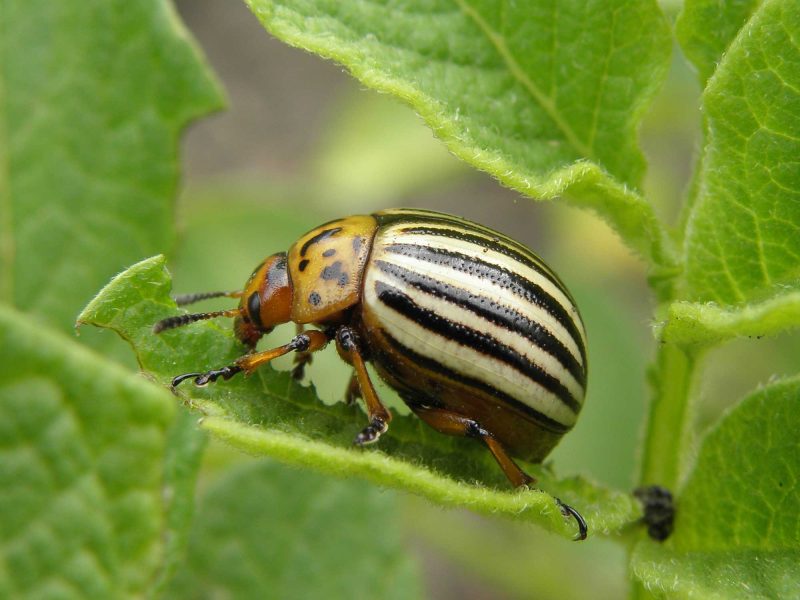
Adult individuals have a convex, shiny body up to 1.2 cm long and 0.6–0.7 cm wide. From afar, the characteristic color of the hard elytra is noticeable - ten black stripes against a light background. This feature is reflected in the Latin name of the species Leptinotarsa decemlineata (“ten lines”). There are dark spots on the head and pronotum.
The Colorado potato beetle undergoes a complete transformation in its development. Eggs of orange or red-yellow color, elongated-oval, shiny. At first, the larvae have a dark gray color; as they grow, they acquire a red color with two rows of black spots. The meaty body of the worm-shaped is provided with bristles. The length of the larva before pupation reaches 1.6 cm.
Which plants are susceptible to infection?

The Colorado potato beetle also, like in its American homeland, eats plants of the nightshade family, mainly potatoes.Food for the insect are tomatoes, eggplant, bell peppers.
What environment does the insect live in?
Adult beetles winter in the soil. Time to surface depends on the temperature of the air and soil. Early awakening is noted when warming atmospheric air to 11 ° C, soil to 6 ° C. Beetles are intensively selected to the surface at an air temperature above 15 °.
The massive release of insects from the soil is accompanied by increased nutrition. Colorado beetles at first can eat tubers and potato sprouts. If food is scarce, then insects fly over long distances in search of food.
Breeding

Mating occurs 3-5 days after the emergence of beetles from the soil. Females lay eggs on potato leaves in groups of 20–30 pieces. Less commonly, in clutch there are 50–70 eggs. More often females “mine” the lower surface of the leaves. Only one female can produce from 1200 to 2000 eggs per year.
Larvae
Embryonic development and larval time depends on the weather. If the spring is cold, then they appear from the eggs in 10-18 days. At a temperature of 20 to 25 ° C, development occurs in 6–7 days.
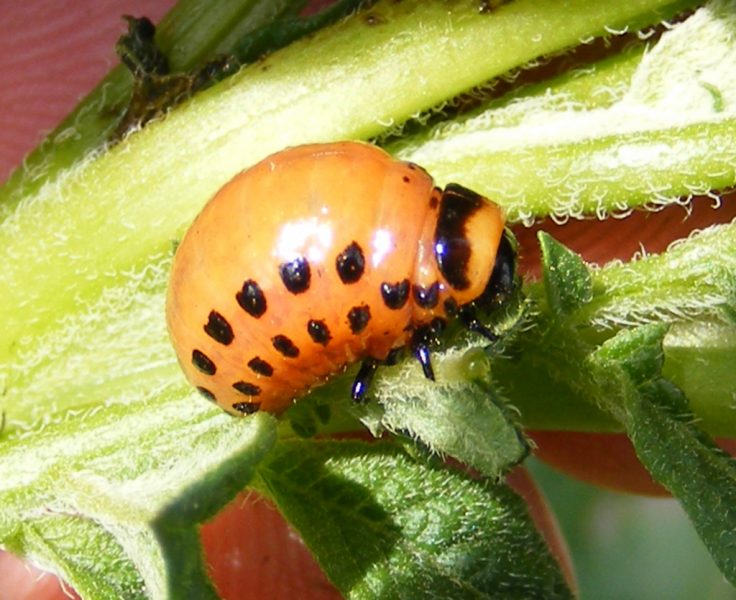
The larvae feed on young leaves and shoots of potatoes and other nightshade plants for 14–24 days. Shedding occurs 3 times. On the leaves of potatoes you can see larvae of four ages.
The younger generation is very voracious. For several days, older larvae leave only veins from the leaves. If the air temperature rises to 12 ° С at night, then food takes place round the clock. After passing through all stages of development, the larvae fall to the soil and go to a depth of 8–20 cm.
The emergence of new generations of beetles
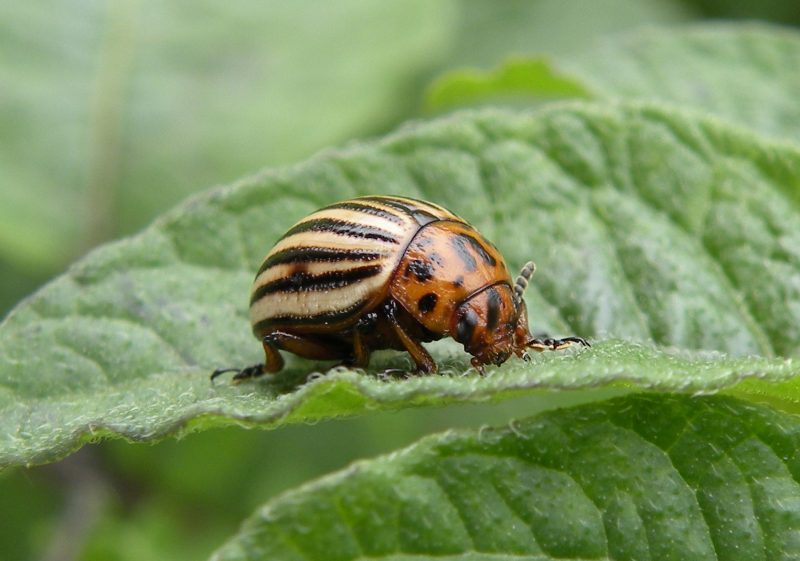
Transformation into a chrysalis, then into an imago, lasts 2-3 weeks (up to 30 days). Young beetles get to the surface in June - July. They begin to eat on the leaves of nightshade plants. Females are able to lay eggs in 1-2 weeks. Some of the young beetles go into the soil to prepare for wintering. These individuals damage tubers most of all.
Colorado potato beetle preparations
A dangerous pest of potatoes and other nightshade plants almost completely eats leaves and ovaries. Agrotechnical and mechanical methods of control are used, however, with a large accumulation of beetles, in large areas they are ineffective.

Historically, the first pesticides based on organochlorine compounds, for example, hexachloran, DDT, are not currently used due to their high toxicity. Organophosphorus preparations such as BI-58, Bazudin are of limited use. They are toxic to humans, bees and other beneficial insects.
The relatively new active ingredients of pesticides are neonicotinoids, pyrethroids. They affect the nervous system of beetles, paralyze and kill pests in a short time.
Pre-sowing treatment of tubers with insecticides Prestige, Prestigeizer based on neonicotinoids is carried out. Actar pesticide is applied to the soil at the bottom of a hole or furrow during planting. After the emergence of seedlings of potatoes and other crops of the nightshade family, spraying continues.
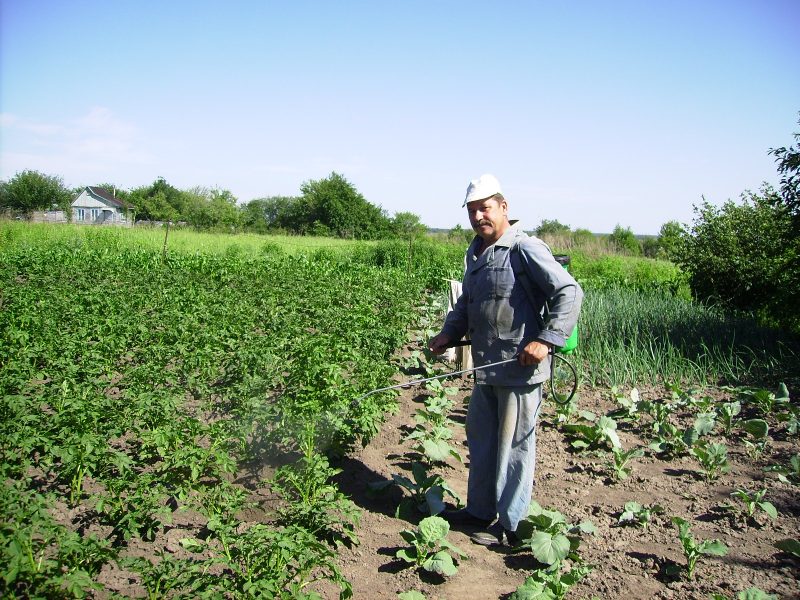
Also in personal subsidiary plots you can use the following drugs: Kinmiks, Decis Profi, Taboo, Confidor Extra. During the growing season, spraying with a biological pesticide Fitoverm.
Top 5 effective remedies
Pesticides based on pyrethroids and neonicotinoids are effective in combating the Colorado potato beetle, quickly decompose in the environment, some can be used during the ripening period.
Brand Names:
- Prestige.
- Taboo.
- Actara.
- Kinmix.
- Decis Profi.
A relatively new insecticide-acaricide from the nicotinoid group is Bankol. The drug has low toxicity for people, warm-blooded animals and bees, is not addictive in the Colorado potato beetle. Bankol is effective against pests that have developed resistance to pesticides of other chemical groups.
Instructions for use and methods of processing plants
In the soil or on the surface of the soil, the preparations are applied in solid or liquid form. Spraying with solutions of pesticides provides uniform wetting of the leaves at low flow rates. You can make poisoned baits and put them on the site.
Prestige from the Colorado potato beetle
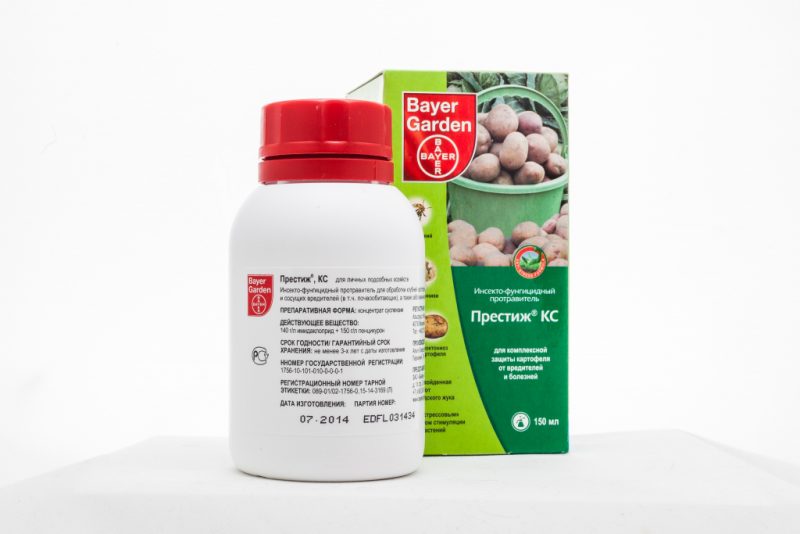
The drug is available in bottles of 1 liter and canisters (5 liters). It is an insecticide and fungicide for the treatment of pests and diseases of potato tubers before or during planting. Prepare the working fluid in accordance with the instructions for use on the packaging and spray planting material.
Taboo from the Colorado potato beetle

Chemical means for seed and tubers is available in bottles (1 l) or canisters (5 l). Processing of potatoes is carried out before planting from the Colorado potato beetle and wireworm, as well as spraying furrows and holes.
Aktara
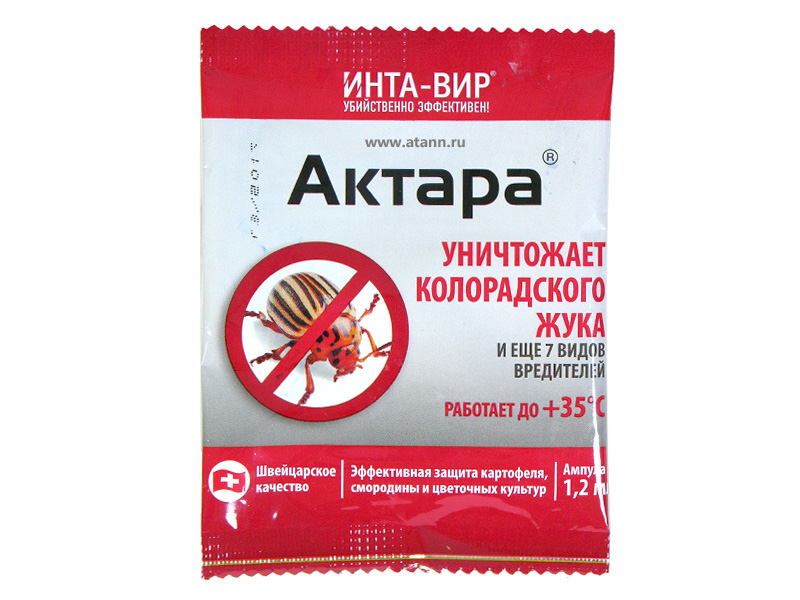
Intestinal contact pesticide contains an active substance from the nicotinoid group. Available in plastic bottles (250 g), sachets (4 g), packed in boxes of 15 pieces. The drug is effective against insects feeding on the underside of the leaf. To obtain a working fluid, 1 g of granules is dissolved in 1 l of water. The furrow bottom is sprayed with the solution during the planting of tubers or seeds, the plants are treated during the growing season.
Kinmix

The remedy for the Colorado potato beetle in the form of an emulsion contains an insecticide from the group of pyrethroids. Available in bottles and cans. Spraying with a solution of the drug is carried out during the growing season. Prepare the working fluid in accordance with the instructions on the packaging.
Decis Profi

Intestinal and contact insecticide is available in bottles (600 g). It is used for spraying potatoes and tomatoes from the Colorado potato beetle during the growing season of plants.
Folk remedies for getting rid of an insect
Plants of the aster family possess insecticidal properties: bitter wormwood, tansy, chamomile (feverfew). Boil 2-3 tbsp. l dried flowering grass tops in 500 ml of water for 10-15 minutes. Insist for a day, then filtered. Dissolve 100 ml of the concentrate in a bucket of water, add 40 g of grated laundry soap. All mix well. The solution is used for spraying tomatoes, sweet peppers, young shoots of potatoes.
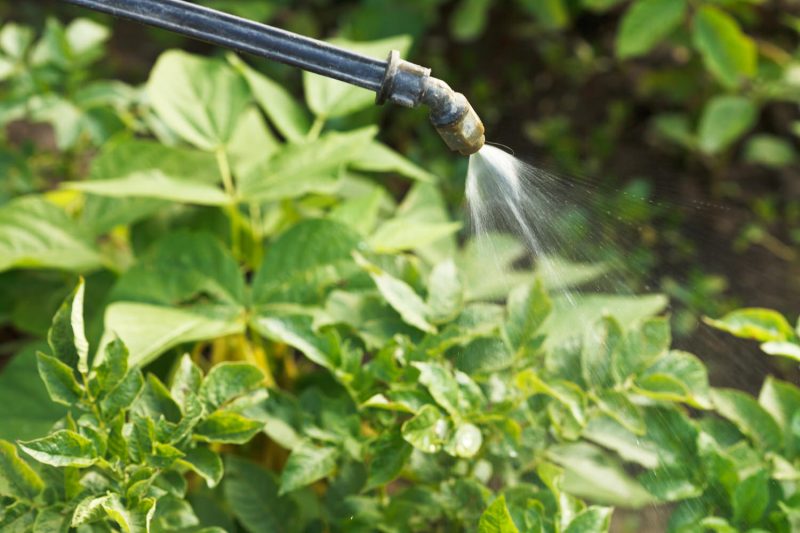
Onion husks fill the bucket 1/3, add warm water and leave to infuse for 5 days. The concentrated solution is diluted with the same volume of water. Plants are sprayed in calm weather.
Potato leaves still wet from dew are sprinkled with dry grounds remaining after brewing coffee. The procedure begins from the moment when the young shoots reach a height of 10 cm. It is advisable to repeat the treatment after rain and heavy dew.
The easiest way to deal with the Colorado potato beetle and its larvae is manual collection. The method is applied in small areas as adults emerge from the soil and larvae emerge from eggs. Collected insects are burned.
Prevention of the appearance of the Colorado potato beetle
Pay attention to crop rotation. Potatoes should not be planted after tomatoes, eggplant and vice versa. It is recommended to deeply loosen the soil so that wintering bugs are closer to the surface, where more than 40% of them die. Weeds must be removed, as they serve as protection for pests, sometimes as a place for laying eggs. It is useful to introduce mixed planting: vegetables or potatoes with horseradish, mint. Pungent odors deter insects.

It is preferable to plant early varieties of potatoes that are less susceptible to defeat by the Colorado potato beetle.
Regular and thorough inspection of each plant on the top and bottom of the leaves is especially important. An ideal time to complete this procedure is the early morning hours. Beetles, larvae and eggs are collected and destroyed. Plants to prevent infection by insects flying from other areas can be covered with a fine mesh.
Various means of combating the Colorado potato beetle will help minimize damage from the harmful pest of potatoes and tomatoes. The competent use of modern insecticides will allow you to grow a full-fledged crop in the garden.












